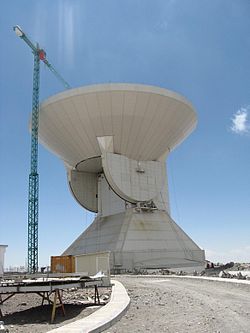Large Millimeter Telescope
 |
|
| Organisation | National Institute of Astrophysics, Optics and Electronics, University of Massachusetts Amherst |
|---|---|
| Location(s) | Volcán Sierra Negra |
| Coordinates | 18°59′09″N 97°18′53″W / 18.98583°N 97.31472°WCoordinates: 18°59′09″N 97°18′53″W / 18.98583°N 97.31472°W |
| Altitude | 4,640 metres (15,200 ft) |
| Wavelength | 0.85–4 mm (75–350 GHz) |
| Built | 2001–2010 |
| First light | June 17, 2011 |
| Telescope style | Bent Cassegrain |
| Diameter | 50 m |
| Secondary dia. | 2.5 m |
| Angular resolution | 5″ at 1 mm |
| Collecting area | 1960 m² |
| Focal length | 525 m |
| Mounting | Altitude-azimuth |
| Website | www |
|
|
|
|
[]
|
|
The Large Millimetre Telescope (LMT) (Spanish: Gran Telescopio Milimétrico, or GTM) was inaugurated in Mexico on 22 November 2006. It is the world's largest single-aperture telescope in its frequency range, built for observing radio waves in the wave lengths from approximately 0.85 to 4 mm. It has an active surface with a diameter of 50 metres (160 ft) and 1,960 square metres (21,100 sq ft) of collecting area.
It is located within Chalchicomula de Sesma municipality, on top of the Sierra Negra, the fifth highest peak in Mexico and an extinct volcanic companion to Mexico's highest mountain, the Pico de Orizaba, in the state of Puebla. Its construction took 10 years, and cost 116 million dollars. It is a binational Mexican (80%) – American (20%) joint project of the Instituto Nacional de Astrofísica, Óptica y Electrónica (INAOE) and the University of Massachusetts Amherst.
Millimetre wavelength observations using the LMT will give astronomers a view of regions which are obscured by dust in the interstellar medium, thus increasing our knowledge about star formation. The telescope is also particularly fitted for observing solar system planetesimals and planets and extra-solar protoplanetary disks which are relatively cold and emit most of their radiation at millimetre wavelengths. There are also proposals for observing fluctuations in the cosmic microwave background as well as active galactic nuclei.
...
Wikipedia
